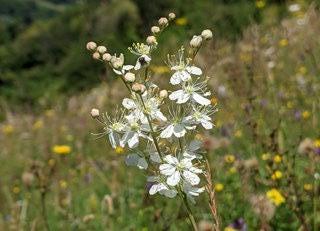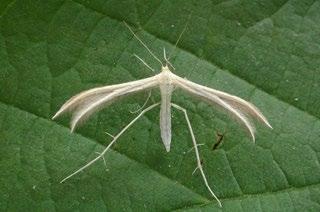
5 minute read
National Plant Monitoring Scheme: Species lists and interactions Sarah Shuttleworth
National Plant Monitoring Scheme: Species lists and interactions
SARAH SHUTTLEWORTH
Advertisement
In my role as Volunteer Manager for the National Plant Monitoring Scheme (NPMS), I was recently leading a training session for some of our volunteers. The location was a beautiful spot in Wiltshire, with excellent Dry Calcareous grassland habitat which supports some interesting invertebrates as well as some great plants. This was a perfect spot to set up a mock plot (5 × 5 metre quadrat) and record the species from the lists. A feature of the NPMS is that recording can be done at different levels, depending on the surveyor’s ID skills: there are 30 species for Dry Calcareous grassland at Indicator level and 23 at Wildflower level. We also covered additional species not on the fine habitat list for those wanting to record at Inventory level (that’s where you do a list of all the plants), but also to look at confusion species. Species of particular note included Filipendula vulgaris (Dropwort), which was abundant. Despite mostly having finished flowering, the volunteers managed to get their eye in, so they could identify the leaves, and even distinguish them from the very similar Sanguisorba minor (Salad Burnet) leaves. Other highlights included Campanula glomerata (Clustered Bellflower), Campanula rotundifolia (Harebell), Cirsium acaule (Dwarf Thistle), Linum catharticum (Fairy Flax), Scabiosa columbaria (Small Scabious) and Bromopsis erecta (Upright Brome).
Many of these species are not only indicative of good quality calcareous habitat, but also have fascinating plant and animal interactions through the evolution of monophagous (eats only one type of food/species or genus) insects reliant on them. In many cases these species are from the family Lepidoptera (moths and butterflies) including many leaf mining species. For example, Blackstonia perfoliata (Yellow-wort) is important for Stenoptilia sophodactylus the Dowdy Plume-moth, whose larvae mine into a basal leaf and then feed on the flower buds. Although
Dr Oli Pescott and NPMS volunteers at our recent quality assurance event. Sarah Shuttleworth

Filipendula vulgaris (Dropwort). Sarah Shuttleworth
widely distributed, it is a local species restricted to sparsely vegetated habitats that Blackstonia and Centaurium erythraea (Common Centaury) grow in abundance (UKmoths website, https://ukmoths.org. uk). Filipendula vulgaris (Dropwort) is important for the nationally scarce Stigmella filipendulae, known as the Dropwort Pigmy (https://westmidlandsmoths.co.uk). Pilosella officinarum (Mouse-ear Hawkweed) even has an aphid dependent on it, the Green Mouse-ear Hawkweed Aphid Aphis pilosellae, which lives under

Thyme Plume-moth (Merrifeldia leucodactyla). Martin Kennard
the rosette leaves and is sheltered by ants, under tents of soil particles (https://influentialpoints.com). The micro moth Rhopobota stagnana larvae feed exclusively on Scabiosa columbaria (Small Scabious) or Succisa pratensis (Devil’s-bit Scabious). The two species of thymes, Thymus drucei and T. pulegioides (Wild Thyme and Large Thyme), which are NPMS indicators as an aggregate, are a food plant for several moths including Thyme Plume Merrifeldia leucodactyla, Pyrausta cingulata and P. sanguinalis, all beautiful and local or scarce (UKmoths website).
Our lists of NPMS indicator species are not only important for monitoring long term change in habitat condition but are also integral components of species-specific plant/animal interactions. By monitoring the change in our habitats, we have the potential to model changes in populations of some of these local and scarce species, if we use these data in conjunction with other recording schemes and databases. Plant species and their communities form the basis of our habitats that other taxa are dependent on. Monitoring change in these plant communities and habitats is therefore essential to understand more about the pressures on our sometimes fragile ecosystems.
If you feel you could contribute to the scheme then please visit our website to find out how to register to take part and where your nearest square is: https://www.npms.org.uk. We also have a recording of a webinar on the survey methodology on our YouTube channel, entitled ‘Introduction to NPMS Survey and Methodology Webinar 25th May 2021’
The National Plant Monitoring Scheme is a UK wide, citizen science, habitat-based, plant monitoring scheme that covers the major freshwater and terrestrial semi-natural habitats. The NPMS provides an indication of changes in plant diversity and abundance, across the UK’s habitats, through time and was designed to meet the need for a standardised approach to plant monitoring which was identified as high priority within the terrestrial biodiversity surveillance strategy published by JNCC in 2008. The NPMS was designed and developed by the BSBI, UKCEH, JNCC and Plantlife and recently we expanded the Scheme into Northern Ireland with partners DAERA. The four original partners came together in 2012 to devise the scheme and the methodologies, before a pilot was run in 2014. In 2015 the NPMS was launched, making 2021 the seventh year for the scheme. 2020 was a pivotal year for the Scheme, as there was enough data to start looking at trends and indicators. The basis of the NPMS is that across the UK, monads (1km squares) have been randomly designated. Volunteers can allocate themselves one or more to survey, up to five plots, twice a year. NPMS focuses on semi-natural habitats with 11 broad habitats divided into 28 fine habitats, including Broad-leaved Woodland, Coastal Habitats, Bog and Wet Heath, Lowland Grassland and Freshwater. Each habitat has a list of indicator species, including negative indicators. Find out more about the NPMS by visiting the website: www.npms.org.uk.
(to find us on YouTube search for ‘NPMS Support’ and please subscribe).
We are always looking for new Mentors for the scheme that could help with species and habitat identification in your local area. Many current mentors are BSBI members and a good proportion of those are County Recorders. We are very grateful to them for the support they offer. Mentoring can be very rewarding and can take up as little or as much time as you want to offer. Contact us if you would like to find out more or have any questions about the scheme.
Sarah Shuttleworth
NPMS Volunteer Manager










